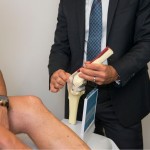
Arthritis of the knee can mean everyday normal activities such as walking and climbing stairs become quite painful and difficult. Osteoarthritis (OA) is the most common type of knee arthritis, usually referred to as a “wear-and-tear” arthritis where the cartilage acting as a cushion in the knee joint gradually wears away and becomes frayed. This causes the space between bones to decrease, and thus causing painful friction of bone rubbing on bone.
As OA develops slowly, it is most commonly found in people above the age of 50. Despite this there are a number of influences that increase the risk of OA for younger people too. These risks for all ages can be broken down into two categories; non-modifiable and modifiable risks.
Non-modifiable Risks:
Family history and ethnicity: It is possible to inherit bone abnormalities around the knees from your family. Studies have also shown higher risks of knee OA among certain ethnic groups.
Gender: Women aged 55 and older are much more likely to develop knee OA than men due to biology, genetics and hormones.
Other illnesses: Those with other illnesses or diseases such as rheumatoid arthritis or metabolic disorders including haemochromatosis (iron surplus) or acromegaly (excess growth hormones) are more likely to develop degenerative changes in knee joints.
Modifiable Risks:
Diet and weight: Your diet and weight can determine the amount of pressure distributed across your joints, especially those around the knees. Every kilo of weight you gain adds an extra 3-4 kg of weight on your knees, resulting in an increase of pain and decrease of functionality in your knees. Adopting a healthy and active lifestyle can help lose weight and reduce joint stress.
Athletics: If you are involved in high impact sports such as soccer, tennis, netball or jogging, the risk of knee OA may be at a higher risk. Whilst taking precautions to avoid injury, it is still important to strengthen knee joints through regular exercise or physical therapy. Opting for lower impact athletics such as swimming or cycling can help prevent the onset of OA.
Repetitive stress injuries and trauma: It is common that a person’s occupation can result in repetitive stress and trauma to knee joints. Those involved in regular activities at work such as kneeling, squatting and lifting heavy weights can increase the risk of knee OA. You can reduce these risks by monitoring and minimising activities that cause physical stress or aggravate the condition.
Dr Shidiak can provide the best customised treatment to meet the needs and lifestyles for his patients through surgical and non-surgical management techniques. Read up on some simple lifestyle changes we recommend that can help reduce the risk of Osteoarthritis here, or get in touch with with us at 02 9806 3333 to arrange for a consultation.


